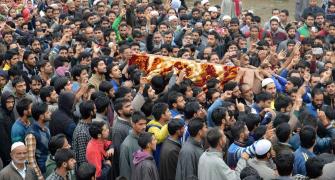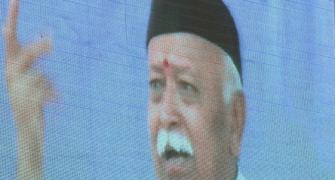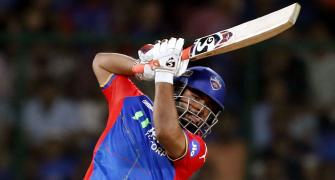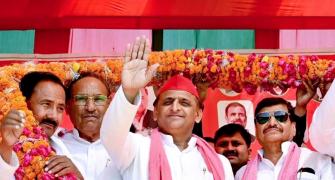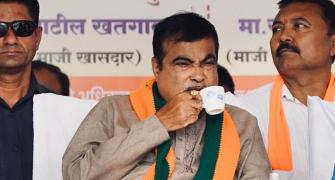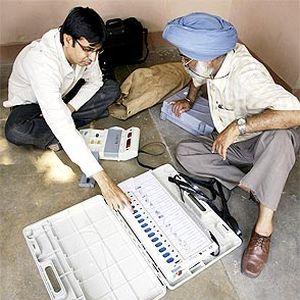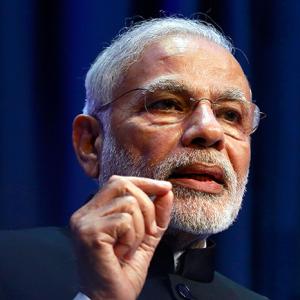'The new generation voter is hyper-nationalistic, but it isn't essentially illiberal.'
'They will find the rants of Adityanath as laughable as Irfan Habib's. They will also find the BJP's polarising approach to vote-gathering unacceptable if it fails to deliver jobs and growth,' says Shekhar Gupta.
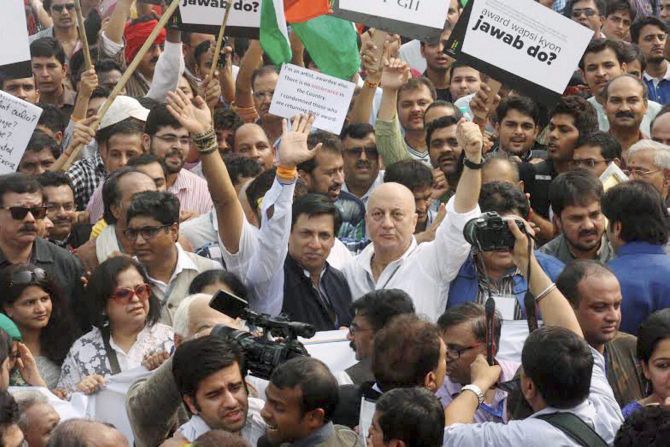
You can phrase this question in many different ways. How liberal are India's liberals? How Left are they? Or how liberal is India's Left? Further on, is the liberal idea of India under an unprecedented threat? If so, how does India fight back?
If it is the Nehruvian idea of Indian liberalism that we are worried about, the time to defend it ended many decades back.
It should have been defended when his daughter signed a treaty with the Soviet Union as a junior strategic ally, threw anybody vaguely of the Right out of the Congress in 1969 and nationalised anything within her sight, leading up to the Emergency that destroyed whatever remained of the original Nehruvian idea of India.
It was in the two decades between 1969 and 1989 that we lost our non-alignment, and whatever economic freedoms we still had in the mixed economy; that we endured the Emergency; and saw rampant insurgencies, the routine dismissal of elected state governments using Article 356, bans on books and movies, the Shah Bano judgement reversal, the unlocking of Ayodhya, the shilanyas (foundation stone laying of the Ram temple), and the launch of an election campaign (Rajiv, 1989) from Ayodhya (Faizabad), with a promise to usher in Ram Rajya.
These two decades were also marked by the absence of the liberal community from the pickets. The sacrifices in the campaign against the Emergency were made by JP's Socialist followers, and forces of the non-secular right: The Jan Sangh and affiliates, even the Shiromani Akali Dal. The only film star to protest was Dev Anand.
The short point is, India's liberal Left was mostly complicit with the establishment during these two decades when the Nehruvian liberal idea of India was destroyed by his descendants.
The durbar is a smug place to be in. Proximity to power enabled them to dominate campuses and curricula and squash any alternative points of view.
A genuine, healthy and intelligent thought on the Indian Right was never allowed to develop. The result now is the rise of a nutty Indian Right, its ideas and prejudices sanctified by cow-worship and fuelled by gobar (dung) gas, its understanding of history determined by folklore and science to any 'Vedic' fiction.
All intolerance and illiberalism must be contested. But some of the shrillness in the ongoing protests is silly. Irfan Habib, a historian at Aligarh Muslim University, seeing similarities between the Rashtriya Swayamsevak Sangh and the Islamic State is a good example. There is much that is wrong with the RSS thought and must be rejected.
There is much else that must be debated. But its lathis are not bazookas and to call it a Hindu ISIS is as abusive and intolerant as the Hindu Right asking critics to go to Pakistan. It is also defeatist and insulting of democracy.
If the RSS is our ISIS, how will you fight it? Will you call the Americans and French and Iranians to come and bomb Nagpur and Jhandewalan?
This is an extreme, but by no means an isolated case of hypocrisy. Binayak Sen's case is another. He was prosecuted for sedition for helping armed Maoists. It became an instant liberal cause as the law of sedition was colonial and oppressive. Dr Sen was built into a liberal hero while the prosecution in Chhattisgarh lost its way. Out on bail, he was even appointed on one of the Planning Commission committees. There was an arguable case against the outdated sedition law that the British used to put down freedom fighters.
The very same sedition law has lately been employed in states as far apart as Gujarat and Tamil Nadu, against Patidar leader Hardik Patel and folk singer S Kovan to little protest by the same liberal leaders.
If the principled issue on the Binayak Sen case was the use of a repressive, archaic law, it is equally wrong to use it against Messrs Patel and Kovan now.
The absence of protest suggests that the outrage in the Binayak Sen case was not about liberty, but ideology. He is an activist and sympathiser of the far Left, and must be defended. Messrs Patel and Kovan aren't.
Under the United Progressive Alliance, these activists enjoyed even greater power because the prime minister here did not control the government and power resided in 10 Janpath, whose durbaris they were happy to become. They opposed every reformist step the UPA took, from airport privatisation to increased FDI limits, WTO, patents, higher education reform, even Aadhar. They cheered all Sonia Gandhi/NAC populism, widening the chasm between the party and the government and playing havoc in that space.
Many of the eminent people leading the current protests now belong in the same category. Let's mention just one, retired navy chief Admiral L Ramdas. He is a wonderful human being and soldier. He joined every conceivable move to block or unsettle the UPA government, opposing infrastructure projects, even high-level appointments. Now he is protesting about the loss of liberty.
Such was the dislike for neo-liberal Manmohan Singh that our Left intelligentsia made common cause with the extreme Right to strangle his government. His years of nine per cent growth were mocked with the taunt of '91 per cent destruction.' This was very much in keeping with the conduct of the political Left, which made common cause with the BJP, voting with it twice, on the nuclear deal and FDI in retail, to try toppling the UPA.
Voters got so fed up, they chose a decisive government and dumped the one that wasn't allowed to function.
The Left intellectual domination of modern Indian thought, and its embrace by the Gandhi dynasty, resulted in lazy, static politics where the word 'secular' became synonymous with Muslim: Note, even in Bihar, the calls to Asaduddin Owaisi to not divide the 'secular vote.' This politics has now unravelled.
A quarter century of reform has produced a new generation of post-ideological, entrepreneurial Indians who need new ideas and leaders to fire their imagination. If they have decided that that leader is Narendra Modi, and not Rahul Gandhi, you can't hold it against them. The RSS-is-ISIS kind of rant will only amuse them.
They are also done with povertarianism. Politically, the Left is now a declining force pan-nationally, and so is caste-based empowerment, irrespective of who wins Bihar. If Nitish Kumar does win, it will be because he has designed a post-Mandal politics and Lalu Prasad has submitted to it. If he doesn't, it will be because he left it too late.
The new generation voter is hyper-nationalistic, but it isn't essentially illiberal. They will find the rants of Adityanath as laughable as Mr Habib's. They will also find the BJP's polarising approach to vote-gathering unacceptable if it fails to deliver jobs and growth. But they won't accept the old notion of hyphenated liberalism (Left-liberal) just for the heck of it. This gives the Hindu Right the upper hand.
A new mainstream liberalism is needed to counter this, not ideological rants or advice from Moody's.
IMAGE: Bollywood actor Anupam Kher, filmmaker Madhur Bhandarkar and other film personalities during their March for India programme over the intolerance issue in New Delhi on Saturday, November 7. Photograph: PTI



